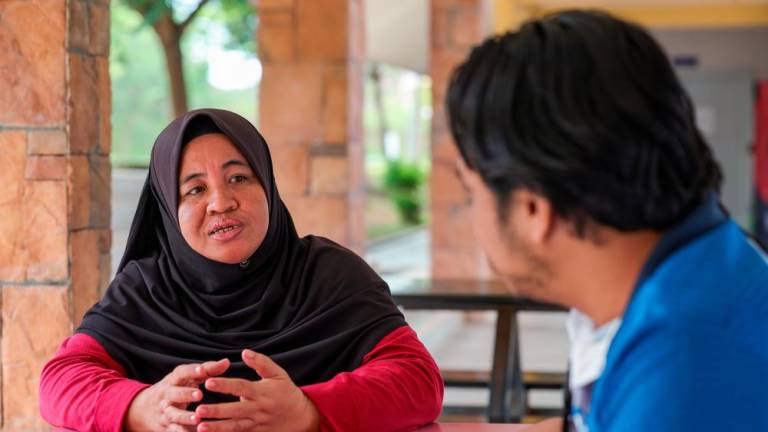AS an education specialist, who has served in schools, the Curriculum Development Centre of the Education Ministry and the Education Faculty of a public university for many years, I feel compelled to write this letter to raise questions and appeal to the cabinet to re-consider its decision on khat.
The decision to go ahead with implementation is insidious, as more controversies will arise in the years to come, when Year 4 pupils progress to years 5 and 6. What then? More rounds of altercation, protest, and negotiation?
Promises made now about “no compulsion”, “no learning” (?) and “no examinations” are for the present not cast in stone for the future.
This is a reality in Malaysian politics. For the sake of real education reforms and nation building, please mull over the following:
1) Time and again, it has been pointed out that the school curriculum is overloaded. There are a thousand and one important things we want pupils to learn. We need to be pragmatic and select the most essential and urgent.
The ministry should focus on how to trim the overloaded curriculum to make learning fun and enjoyable for schoolchildren, especially those in primary schools.
The dismal revelation by Dr Sivachandralingam (theSun, Aug 8,) should certainly raise an alarm and deep concerns: A recent study has shown that as many as 30% of pupils from Tamil schools consistently fail in Bahasa Melayu (BM)!
Will the introduction of khat improve their learning and mastery of BM? Very unlikely, it can only make things worse, because the inclusion of this new language element – whether three or six pages in the textbook – will only dilute the original BM curriculum, taking up precious teaching time that should rightly be devoted to helping these under-performing pupils read and write BM.
2) Pupils in the vernacular primary schools at such a young and tender age have to grapple with the learning of three languages: two using the Roman alphabet – English and BM – and the third using an entirely different language form and writing system, be it Chinese or Tamil. And now, they have to learn a third, the Jawi alphabet.
In this context, statements such as “appreciation” and “no learning” seem baffling, to say the least.
How will teachers present khat/Jawi calligraphy in class without teaching the pupils the individual letters in the Jawi alphabet? Unless it is simply copying the khat as a pretty drawing or pattern. If so, how does this kind of “drawing” activity enrich and enhance the learning of BM?
3) An article in Sin Chew (Aug 8) by Datuk Wu Hen Can, who attended a special meeting held by the minister and his deputy on Aug 1, has drawn my attention to more curricular concerns.
It was mentioned that in the DSKP (Dokumen Standard Kurikulum dan Pentaksiran), the learning outcomes as reflected there (4.4.2 and 4.4.2) clearly indicate that the khat activity is not limited to mere superficial recognition and “appreciation”.
They require pupils to be able to identify and pronounce individual letters in Simpulan Bahasa written in the seni khat; and in addition, to be able to write the same. Not easily attainable learning outcomes, and a lot of learning, I must say.
So, unless these expected learning outcomes have been removed from the document and curriculum plan as proposed by Wu in that meeting, I do not see how khat can be used in class as an activity for learning BM, no matter how creative the teachers are, without the need for pupils to learn all the letters in the Jawi alphabet.
My main concern now is: Will such an added burden of learning another alphabet help our Year 4 pupils read and write better BM? Is there a need for them to learn Jawi to read and write better BM?
4) Are all BM teachers in vernacular schools equipped with the knowledge and skills to teach khat? Some people go to the extent of suggesting that we have many unemployable graduates who can fill the void in such skills. This is beside the point. More important questions are: Is khat really “optional”, and can teachers or pupils choose not to teach or learn it, especially when it is not included in examinations?
What will happen in subsequent Year 5 and Year 6 after this? For those teachers who are overly zealous in striving to attain those learning outcomes as reflected in the DSKP, will they end up spending too much time teaching the new alphabet at the expense of honing pupils’ reading and writing skills in BM, which should be a priority in our curriculum reform effort?
Let us heed the criticism of past cabinet ministers and the learned views of scholars well-versed in Jawi and its history. These people do not think there is a need for pupils in vernacular schools to learn khat, and they said so with no hidden agenda.
Why not just focus on real education reforms and avoid diversions that court controversies or provide fodder for opportunistic politicians to create disharmony. To give due credit, the existing Year 5 BM textbook already includes adequate and very appropriate content to create awareness and impart basic knowledge about khat/Jawi, and even much more. “Don’t fix it if it ain’t broke”.
Let us focus on real education reforms by:
1) Continuing to channel efforts and resources to narrow the gap between the haves and have-nots, between urban and rural schools; in terms of IT infrastructure, physical amenities and facilities in schools. Make all schools truly conducive for learning, reduce class size and improve instruction to make teaching and learning more effective and fun.
2) Laying a strong foundation to develop in our students STEM skills, higher-order thinking skills, and proficiency in English and other languages that will help them meet the challenges of Industrial Revolution 4.0 and globalisation; and
3) Paying due attention to the holistic development of individual students much emphasised in the Malaysian National Philosophy of Education (1988) which is so eloquently articulated and yet often overlooked or slighted in our often blinkered – or politicised? – views of education reforms. The furore over the inclusion of khat in the vernacular primary school Year 4 curriculum is not going to blow over soon.
It is of public interest that answers to questions raised above, and the rationale behind the cabinet decision to doggedly proceed with implementation, must be made crystal clear without ambiguities, to address the concerns of all stakeholders, and allay their misgivings.
More importantly, all decision-makers, especially the Education Ministry must have the young pupils’ best interest at heart, bearing in mind that a good curriculum is one that is planned by taking into consideration the needs of learners and input from all stakeholders, including the parents, teachers and the community at large.
Dr Gan Siowck Lee
Kuala Lumpur










